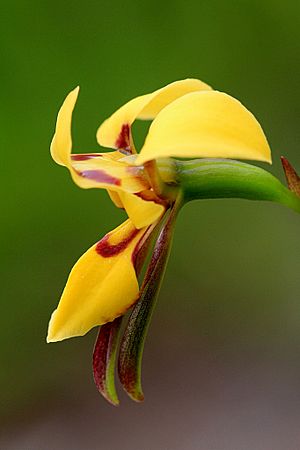Short-leaved donkey orchid facts for kids
Quick facts for kids Short-leaved donkey orchid |
|
|---|---|
 |
|
| Scientific classification | |
| Genus: |
Diuris
|
| Species: |
brevifolia
|
The Short-leaved donkey orchid (scientific name: Diuris brevifolia) is a special type of orchid. It only grows in South Australia, which means it's endemic there. This orchid has a few thin, twisted leaves. It also has a stem that can grow up to five bright yellow flowers. These flowers have cool brown marks and a large, spreading labellum (which is like a lip). This orchid blooms later in the year compared to other donkey orchids.
Contents
What the Short-leaved Donkey Orchid Looks Like
The Short-leaved donkey orchid is a plant that grows from a tuber (a swollen underground stem, like a potato). It lives for many years, which means it's a perennial herb. It usually has four to eight leaves that are often twisted. These leaves are about 70 to 120 mm (2.8 to 4.7 inches) long and 3 to 4 mm (0.12 to 0.16 inches) wide.
The plant grows a flowering stem that can be 150 to 400 mm (5.9 to 15.7 inches) tall. On this stem, you can find up to five bright yellow flowers. Each flower is about 15 to 20 mm (0.59 to 0.79 inches) wide.
Flower Parts
The flowers have interesting features:
- The dorsal sepal (the top part of the flower) is upright or bends upwards. It's about 12 to 15 mm (0.47 to 0.59 inches) long and 6 to 7 mm (0.24 to 0.28 inches) wide. It has two brown spots at its base.
- The lateral sepals (the two side parts) are greenish and point downwards. They are about 13 to 16 mm (0.51 to 0.63 inches) long.
- The petals (the main colorful parts) stand up or curve backward. They have a dark brown stalk about 4 to 6 mm (0.16 to 0.24 inches) long. The petal blade itself is about 9 to 11 mm (0.35 to 0.43 inches) long.
- The labellum (the large, lip-like part of the flower) is egg-shaped. It's about 12 to 15 mm (0.47 to 0.59 inches) long and 7 to 8 mm (0.28 to 0.31 inches) wide. It has side parts that are about 5 to 6 mm (0.20 to 0.24 inches) long.
- There are two parallel, ridge-like bumps called calli on the labellum. They are about 6 to 7 mm (0.24 to 0.28 inches) long and are outlined in brown.
This orchid usually blooms from October to December.
How it Got its Name
The Short-leaved donkey orchid was first officially described in 1922. A scientist named Richard Sanders Rogers wrote about it in a scientific paper.
The scientific name brevifolia comes from two Latin words. Brevis means "short," and folia means "leaves." So, the name simply means "short-leaved," which describes one of the plant's features!
Where it Lives
The Short-leaved donkey orchid can be found in different places. It grows in open areas called heath, as well as in forests and woodlands. However, it likes to grow most often near the edges of swamps and along river flats. You can only find this orchid in the southern part of Adelaide and on Kangaroo Island in South Australia.
Protecting the Orchid
Sadly, the Short-leaved donkey orchid is becoming much rarer. Its numbers have dropped a lot in recent years. Because of this, it is listed as "endangered" in South Australia. This means it's at a very high risk of disappearing forever if we don't protect it.
The main reasons this orchid is in danger are:
- Land use: Human activities that change the land in ways that are not good for the orchid.
- Fire: Not enough fires, or fires happening at the wrong time, can harm the orchid's habitat.
Protecting this special orchid means making sure its natural home is safe from these threats.

